Understanding Canadian Car Coverage: A Comprehensive Guide

Navigating the world of car coverage in Canada can be complex, but understanding the basics can help you make informed decisions and potentially save money without compromising on coverage.
Mandatory Coverage in Canada
In Canada, car coverage is regulated at the provincial level, but there are some commonalities across the country. Most provinces require the following types of coverage:
- Third-Party Liability: Covers damages you may cause to others or their property.
- Accident Benefits: Provides coverage for medical expenses and loss of income if you're injured in an accident.
- Direct Compensation Property Damage (DCPD): Covers damage to your vehicle when another driver is at fault (not available in all provinces).
- Uninsured Automobile: Protects you if you're in an accident with an uninsured driver.
Optional Add-ons for Enhanced Safeguarding
While the mandatory coverage provides a solid foundation, many Canadians opt for additional safeguard:
- Collision Coverage: Pays for damage to your car if you're at fault in an accident.
- Comprehensive Coverage: Protects against non-collision related damages like theft, vandalism, or natural disasters.
- Specified Perils: Covers specific risks you choose to insure against.
- All Perils: Combines collision and comprehensive coverage for maximum safeguarding.
Factors Affecting Your Premium
Understanding what influences your coverage rates can help you find ways to save:
- Driving record and claims history
- Type and age of your vehicle
- Annual mileage
- Where you live
- Age and gender
- Coverage types and deductibles chosen
Tips for Saving on Car Coverage
Here are some strategies to help reduce your premiums without sacrificing quality coverage:
- Bundle your auto coverage with home or other policies
- Increase your deductible if you can afford a higher out-of-pocket expense
- Install anti-theft devices in your vehicle
- Take a recognized driver training course
- Pay your premium annually instead of monthly
- Ask about usage-based coverage programs
- Maintain a good credit score (where applicable)
- Shop around and compare quotes from different insurers
The Importance of Regular Review
Your coverage needs may change over time. It's crucial to review your policy annually and update it to reflect changes in your life, vehicle, or driving habits. This ensures you're always adequately protected while potentially uncovering new discounts opportunities.

Remember, while saving money is important, the primary goal of coverage is to protect you financially. Always ensure you have adequate coverage for your needs and circumstances. By understanding the Canadian car coverage landscape and implementing smart strategies, you can strike the right balance between cost and coverage.